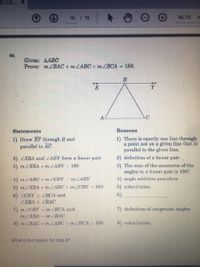
Elementary Geometry For College Students, 7e
7th Edition
ISBN: 9781337614085
Author: Alexander, Daniel C.; Koeberlein, Geralyn M.
Publisher: Cengage,
expand_more
expand_more
format_list_bulleted
Concept explainers
Question

Transcribed Image Text:IS GE. X
16 / 19
66.7%
86.
Given: AABC
Prove: m/BAC + m LABC+ mZBCA = 180.
B
A
Statements
Reasons
1) Draw XY through B and
parallel to AC.
1) There is exactly one line through
a point not on a given line that is
parallel to the given line.
2) ZXBA and ZABY form a linear pair.
2) definition of a linear pair
3) The sum of the measures of the
angles in a linear pair is 180.
3) m ZXBA + m LABY = 180
4) m LABC + mZCBY-MLABY
1) angle addition poetulate
5) mZXBA + m ZABC + mZCBY = 180
5) substitution
6) CBY = ZBCA and
LXBA ZBAC
6)
7) definition of congruent angles
7) m ZCBY = m ZBCA and
MZXBA m ZBAC
8) mZBAC + m LABC + m ZBCA = 180
8) substitution
What is the reason for step 6?
Expert Solution
This question has been solved!
Explore an expertly crafted, step-by-step solution for a thorough understanding of key concepts.
This is a popular solution
Trending nowThis is a popular solution!
Step by stepSolved in 2 steps with 2 images

Knowledge Booster
Learn more about
Need a deep-dive on the concept behind this application? Look no further. Learn more about this topic, geometry and related others by exploring similar questions and additional content below.Similar questions
- Which lines are parallel? 1:7(1) = (7+2 · 7) + t · (7 – 2 ·7 +3.7), 1,: ,(u) = (7 + 2 - R ) + u · ( 7 + 2 ·} – 3. R), 13: r(v) = (6-7-7) – v· (2.7 – 4:7 +6.F), - V. 4:7(w) = .7- w:7 - (1 • W 2 • W 3 OUniversitarrow_forwardFigure 2.7 In Exercises 48 and 49, determine whether the lines x = p + su and x = q + tv intersect and, if they do, find their point of intersection. 48. p = 2,q=2 u= V= -1 1arrow_forward
Recommended textbooks for you
 Elementary Geometry For College Students, 7eGeometryISBN:9781337614085Author:Alexander, Daniel C.; Koeberlein, Geralyn M.Publisher:Cengage,
Elementary Geometry For College Students, 7eGeometryISBN:9781337614085Author:Alexander, Daniel C.; Koeberlein, Geralyn M.Publisher:Cengage, Elementary Geometry for College StudentsGeometryISBN:9781285195698Author:Daniel C. Alexander, Geralyn M. KoeberleinPublisher:Cengage Learning
Elementary Geometry for College StudentsGeometryISBN:9781285195698Author:Daniel C. Alexander, Geralyn M. KoeberleinPublisher:Cengage Learning

Elementary Geometry For College Students, 7e
Geometry
ISBN:9781337614085
Author:Alexander, Daniel C.; Koeberlein, Geralyn M.
Publisher:Cengage,

Elementary Geometry for College Students
Geometry
ISBN:9781285195698
Author:Daniel C. Alexander, Geralyn M. Koeberlein
Publisher:Cengage Learning